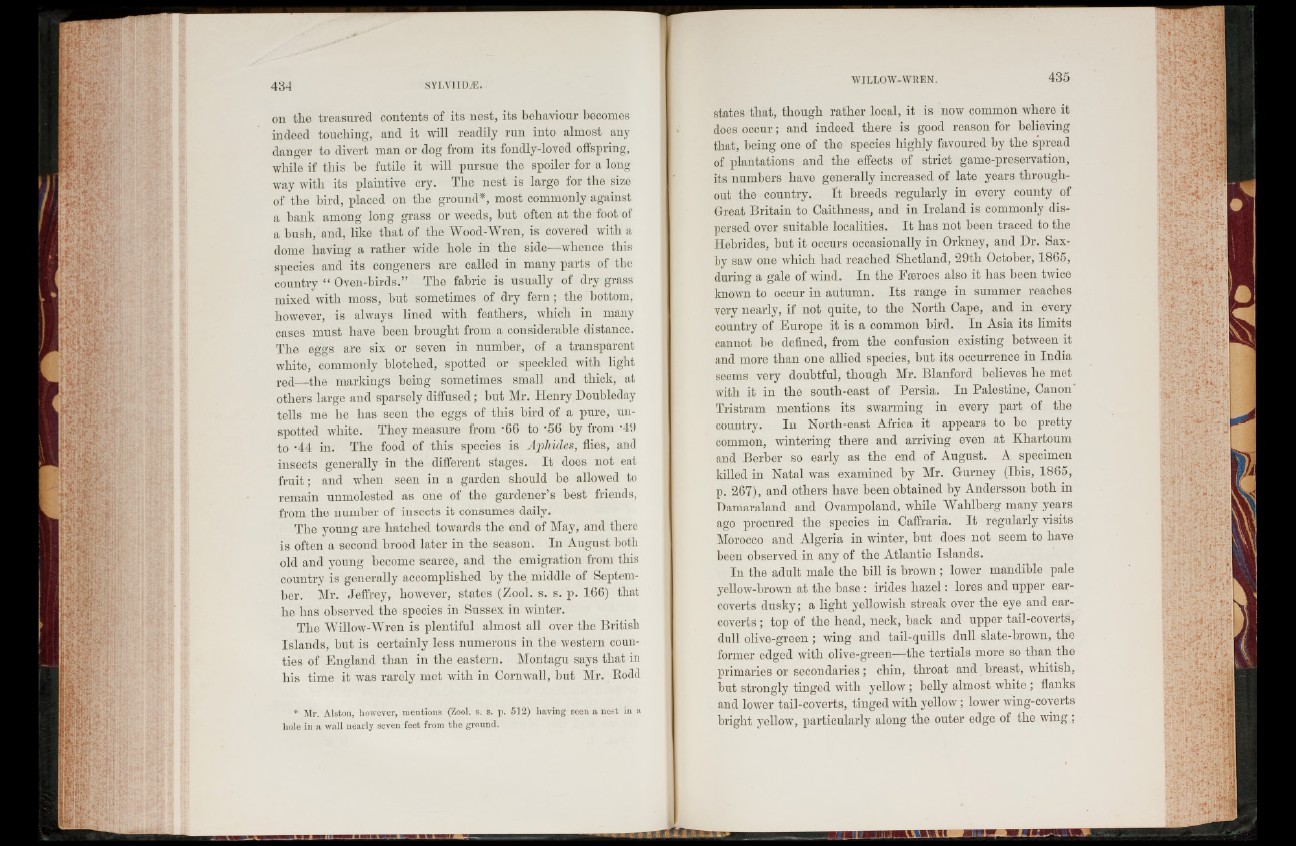
on the treasured contents of its nest, its behaviour becomes
indeed touching, and it will readily run into almost any
danger to divert man or dog from its fondly-loved offspring,
while if this be futile it will pursue the spoiler for a long
way with its plaintive cry. The nest is large for the size
of the bird, placed on the ground*, most commonly against
a bank among long grass or weeds, but often at the foot of
a bush, and, like that of the Wood-Wren, is covered with a
dome having a rather wide hole in the side—whence this
species and its congeners are called in many parts of the
country “ Oven-birds.” The fabric is usually of dry grass
mixed with moss, but sometimes of dry fern ; the bottom,
however, is always lined with feathers, which in many
cases must have been brought from a considerable distance.
The eggs are six or seven in number, of a transparent
white, commonly blotched, spotted or speckled with light
recl—the markings being sometimes small and thick, at
others large and sparsely diffused; but Mr. Henry Doubleday
tells me he has seen the eggs of this bird of a pure, unspotted
white. They measure from -66 to -56 by from -49
to -44 in. The food of this species is Aphides, flies, and
insects generally in the different stages. I t does not eat
f ru it; and when seen in a garden should be allowed to
remain unmolested as one of the gardener’s best friends,
from the number of insects it consumes daily.
The young are hatched towards the end of May, and there
is often a second brood later in the season. In August both
old and young become scarce, and the emigration from this
country is generally accomplished by the middle of September.
Mr. Jeffrey, however, states (Zool. s. s. p. 166) that
he has observed the species in Sussex in winter.
The Willow-Wren is plentiful almost all over the British
Islands, but is certainly less numerous in the western counties
of England than in the eastern. Montagu says that in
his time it was rarely met with in Cornwall, but Mr. Bodd
* Mr. Alston, however, mentions (Zool. s. s. p. 512) having seen a nest in a
hole in a wall nearly seven feet from the ground.
states that, though rather local, it is now common where it
does occur; and indeed there is good reason for believing
that, being one of the species highly favoured by the spread
of plantations and the effects of strict game-prcservation,
its numbers have generally increased of late years throughout
the country. I t breeds regularly in every county of
Great Britain to Caithness, and in Ireland is commonly dispersed
over suitable localities. I t has not been traced to the
Hebrides, but it occurs occasionally in Orkney, and Dr. Sax-
by saw one which had reached Shetland, 29th October, 1865,
during a gale of wind. In the Faeroes also it has been twice
known to occur in autumn. Its range in summer reaches
very nearly, if not quite, to the North Cape, and in every
country of Europe it is a common bird. In Asia its limits
cannot be defined, from the confusion existing between it
and more than one allied species, but its occurrence in India
seems very doubtful, though Mr. Blanford believes he met
with it in the south-east of Persia. In Palestine, Canon
Tristram mentions its swarming in every part of the
country. In North-east Africa it appears to be pretty
common, wintering there and arriving even at Khartoum
and Berber so early as the end of August. A specimen
killed in Natal was examined by Mr. Gurney (Ibis, 1865,
p. 267), and others have been obtained by Andersson both in
Damaraland and Ovampoland, while Walilberg many years
ago procured the species in Caffraria. I t regularly visits
Morocco and Algeria in winter, but does not seem to have
been observed in any of the Atlantic Islands.
In the adult male the bill is brown ; lower mandible pale
yellow-brown at the base : irides h azel: lores and upper ear-
coverts dusky; a light yellowish streak over the eye and ear-
coverts; top of the head, neck, back and upper tail-coverts,
dull olive-green ; wing and tail-quills dull slate-brown, the
former edged with olive-green—the tertials more so than the
primaries or secondaries; chin, throat and breast, whitish,
but strongly tinged with yellow; belly almost white ; flanks
and lower tail-coverts, tinged with yellow; lower wing-coverts
bright yellow, particularly along the outer edge of the wing ;